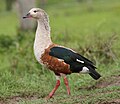Neochen
Appearance
| Neochen | |
|---|---|

| |
| Orinoco goose, Neochen jubata | |
| Scientific classification | |
| Domain: | Eukaryota |
| Kingdom: | Animalia |
| Phylum: | Chordata |
| Class: | Aves |
| Order: | Anseriformes |
| Family: | Anatidae |
| Subfamily: | Tadorninae |
| Genus: | Neochen Oberholser, 1918 |
| Type species | |
| Anser jubatus[1] von Spix, 1825
| |
| Species | |
Neochen is a genus of birds in the family Anatidae.
Extant species
[edit]The genus contains a single living species:[2]
| Image | Scientific name | Common Name | Distribution |
|---|---|---|---|
 |
Neochen jubata | Orinoco goose | South America |
Fossil species
[edit]References
[edit]Wikimedia Commons has media related to Neochen.
- ^ "Anatidae". aviansystematics.org. The Trust for Avian Systematics. Retrieved 2023-08-05.
- ^ Gill, Frank; Donsker, David; Rasmussen, Pamela, eds. (January 2021). "Screamers, ducks, geese & swans". IOC World Bird List Version 11.1. International Ornithologists' Union. Retrieved 12 June 2021.


